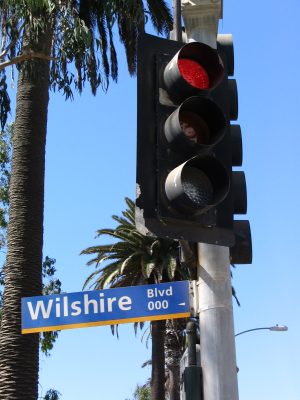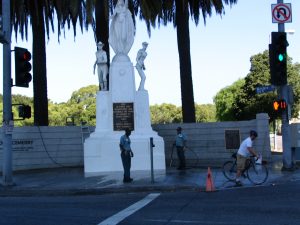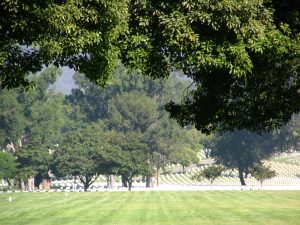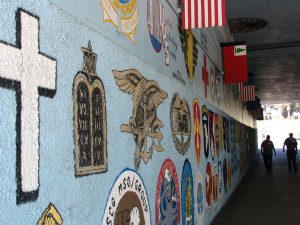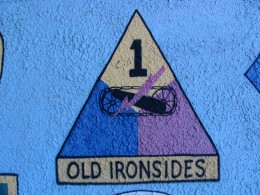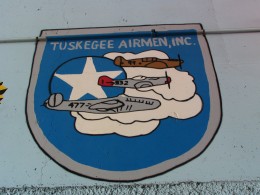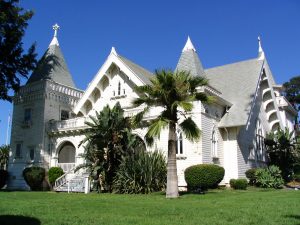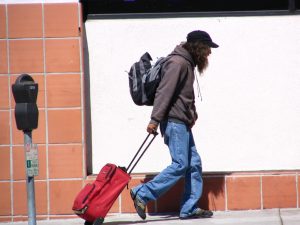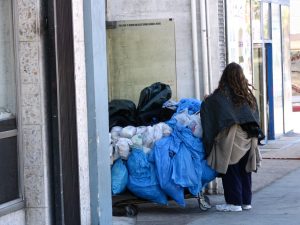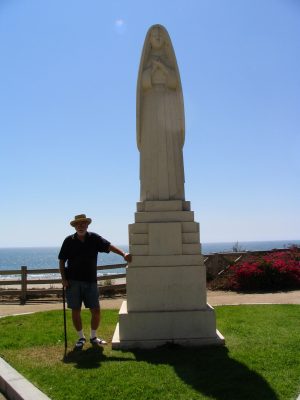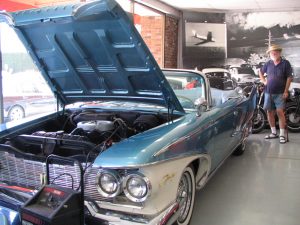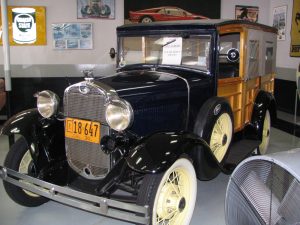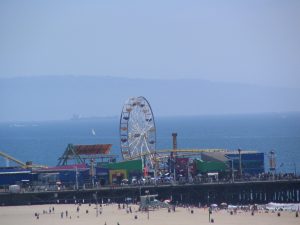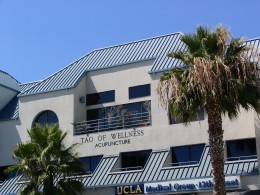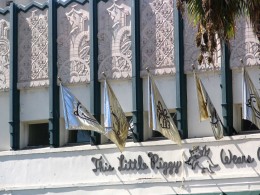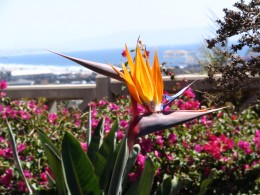Sounds like a spaghetti western, right? I had expected today to be pretty boring, since I’d driven the route and knew we’d start the day going through the edge of the Military Cemetery and then the vast campus of the Veterans Administration. Not so boring as a golf course, I’ll grant you, but still. It just goes to show you that you never know what hidden treasures are out there until you get out of your car and hit the ground running. Well, hobbling, in my case, but I get there.
We began in Westwood, and Wilshire at that point is a series of odd skyscrapers, most of them containing banks. Just a wee bit north is a really nice commercial district catering to UCLA students and residents of Brentwood, but we’ve been through that before. Soon we were in Federal territory, with a big Federal building directly in front of us, no doubt full of people doing Federal-type things with your Federal tax money. It didn’t look too interesting, so we crossed to the north side of the road where there was a statue of two soldiers on either side of a naked woman. Well, she had a cloak, but it was wide open. She had one hand up in the air, asking for something from someone up there, I guess. I should have gone up closer and found out who she personifies, but there were two Federal employees with a high-pressure water hose blasting accumulated dirt from her private parts, so I didn’t. Just beyond these three was a long iron fence, and on the other side was a huge green lawn that seemed empty until you spotted the small headstones set in it, each exactly alike.
I didn’t serve in the military, so there’s no way for me to understand why so many veterans choose to be buried in similar settings. Is it a buddy thing? Is it because Uncle Sam will plant you there for free? I’m not one who really thinks much about monuments, I’d be perfectly happy to donate this old carcass to science, for transplants if there’s anything useful left, for dissection at a medical school if not, or be cremated, or simply tossed in a dumpster or ground up for dog chow. Even if I believed in an afterlife I strongly doubt that the disposal of your mortal remains has any bearing on it. But at those rare times when I do think about monuments, I guess I’d want something that stands out a little. No pyramid, no fancy statues, maybe just a witty epitaph or a stone that was a little different from those of my eternal neighbors. These stones are so uniform. The only uniform I’ve ever worn in my life was in the high school band, and I wore it because I liked to play and I looked, frankly, pretty snazzy in it. Maybe the last snazzy moment of my life. The idea of being composted in a row of completely identical compost piles has absolutely no attraction for me. Being laid down in neat, orderly rows … that’s for soldiers, and if you get to be ninety and die and still think of yourself as a soldier … well, you’re weird to me. No offense meant. Takes all kinds.
At certain points you can see the hillside far in the distance, and that’s more like Arlington, with erect stones, all in perfect rows. Why are some sections like that, and some with the flush-to-the-ground headstones? I don’t know. We’ve been over there, and like all military cemeteries I’ve ever seen it’s neat, orderly, well-kept, and very sad. I have to keep telling myself that not all of these boys (they’re mostly male) were killed in combat. Many lived long lives, many of them never plagued by nightmares. Still, these green fields are the final result of war. There is unspeakable violence hidden in these stones.
Ducking under the 405 Freeway we were soon in the Veterans Administration. You can’t tell from the ground, but take a look at the map and you’ll see this is a truly huge complex, almost exactly the same size as the 36-hole Los Angeles Country Club, in fact, that extends on both sides of the road. Much of it looks to be park-like, but there are several large hospitals, and a lot of what look like barracks housing. Nursing homes for vets who are circling the drain? I don’t know, we didn’t go that far inside.
What we did do was take the side road that doesn’t have a name on the map, because at this point Wilshire goes up and over, and the sidewalks up there are very narrow. If you walk down this side road, which is where the buses stop to pick up passengers, you will soon see part of a large mural painted on the concrete of the overpass. It looks like it is still in progress. There is what looks like a paratrooper with a goofy grin, a female aviator with the World War II look—lots of women flew combat aircraft, ferrying them over to Europe for the guys to fight in—a tribute to the submarine veterans of WWII, and a remembrance of POW/MIAs: “Never Forgotten.”
But the best part is really in the tunnel under the street. The walls are covered with very good renditions of unit patches, the sort soldiers and sailors wear on their shoulders. I am far from familiar with this sort of stuff, but even I recognized some, and I’m sure soldiers and ex-soldiers would know a lot more of them. Probably a good chance they could find their old unit up there somewhere. The mural was done 12 years ago (and dedicated by “Maj. Gen. Johnny Grant”—who always presides over star ceremonies on Hollywood Boulevard and must be a Major General of Public Relations), and is in wonderful shape, unlike many we’ve seen. Not a speck of graffiti. I looked around at who was walking through this tunnel, and realized a high proportion of them were large men, certainly vets, who would probably pinch the heads off of any pencil-neck taggers or gangbangers who tried anything stupid in this hallowed hall.
Above, the concrete was painted blue, with some clouds, and a flight of what I’m pretty sure were P-47 Thunderbolts passing over. That was the largest fighter plane of WWII, and one hell of an aircraft. Like flying a bathtub, some of the pilots said, but brother, you didn’t want to be on the ground when it made a strafing run. On another part of the ceiling paratroopers were coming down.
Out of the tunnel and up a slight rise was what was unmistakably a church, with squat steeples and white-painted sides. The closer we got, the more obvious it became that it was sorely in need of repair. Paint was flaking away. I wouldn’t doubt it was full of termites. It’s still pretty. Maybe somebody will restore it some day. It had two entrances, one for Catholics and one for Protestants. Didn’t see a Jewish or Muslim entrance.
There’s a theater there, too, the Wadsworth, which is not derelict, but puts on several live shows and concerts every year. From the seating chart it seems to be quite substantial in size, and it’s recently been renovated. This year they’re presenting the off-Broadway musical “Altar Boyz.” I haven’t figured out what tickets cost, or how to get them.
At the western corner of the complex is the National Veterans Park, which is a work in progress at the moment. They’ve put up a handsome gate and fence, but there’s nothing much inside it yet. I gather they’re raising money.
Once out of the Veterans Park we entered an area which seemed like the last gasp of Los Angeles’s tall, modern buildings. Shortly beyond that is Santa Monica, which is much more subdued.
I was struck by the proximity of the Veterans complex, the hospital and such, and the graveyard just over the freeway. All they needed to make the symmetry perfect was to turn this section of LA into a basic training camp. So you make soldiers here, then when they come back from whatever hellhole with a lot of oil underground we’re fighting to “free” this year, you patch them up (or not) at the VA. Maybe we should start expanding the VA right now so we’ll be ready for the casualties of the Third Gulf War, the one with Iran. When they no longer need medical care, plant them in the cemetery. A perfect meat grinder. Cannon fodder in one end, mulch into the ground at the other. The quick, the slow, and the dead.
I mean no disrespect to our armed forces, past and present. But I do feel sad for those serving today, who must tell themselves they’re fighting for the same things their grandfathers did in WWII, when what they’re really fighting for is geopolitical theories coming from people who didn’t serve themselves, who had “other priorities,” who joined the National Guard and didn’t show up. Cakewalk. Mission accomplished. Surge. Another Korea. No end in sight, and deployments stretching out longer and longer, stress building up, tearing the army apart—when’s the last time you saw so many generals saying this was all a monumental clusterfuck? Never, I’d say. How many times has an administration proposed cutting combat pay while soldiers were in the field fighting? Never, would be my guess. Bush did just that.
Enough. I could go on and on, but I’m making myself sick.
We made it to Santa Monica … and then considerably farther. I had misjudged the distance between express bus stops. We probably should have turned back at Bundy Street, but went on to 26th, where I thought there was a stop. There wasn’t. This turned out to be the biggest gap on the 720 line, and we had to go 3.5 miles from where we’d parked, all the way to 14th Street. We could actually see the ocean from there, but there was no way I was going to do another mile that day. We boarded the bus and went home. Next time we’ll have a short walk to the sea, and reward ourselves with a good lunch at one of the many Santa Monica restaurants down there.
Santa Monica
… born 332 A.D., died 387, is the patron saint of wife beaters … though the Church says she represents patience, wives, mothers, and abuse victims. The story goes that her husband, a violent man, never beat her. That’s because she knew her place: “If you can master your tongue, not only do you run less risk of being beaten, but perhaps you may even, one day, make your husband better.” In other words, shut up, bitch, and do as you’re told. They say it worked for her. Hubby reformed and found God. They also say a fairy leaves a dime if you put a tooth under your pillow. I’m dubious. I’ll bet she fell down the stairs a lot, and ran into quite a few doors. She’s most famous for being the mother of Saint Augustine, the guy who came up with the doctrine of original sin. As I understand it, that’s the concept that we’re fucked from the moment we’re born, before we’ve even had the chance to actually enjoy sinning a little. Thanks a lot, Augie, humanity really needed that idea. Asshole.
She’s also the person whose feast day marked the first visit of western slavers—sorry, I meant missionaries—to the area. There they found Indian tribes relaxing around swimming pools and on the beach, sipping drinks with umbrellas in them and thinking about visiting their grandchildren, and things haven’t changed much since then. Santa Monica is a small town completely surrounded by Los Angeles with nowhere to grow but up or into the ocean. They tried the ocean part last century with a lot of amusement piers, of which only one remains, at the foot of Colorado Avenue. They have resisted the urge to grow upward. Oh, there’s some tall buildings by the shore, but mostly the town is built a lot lower to the ground than, say, Miami Beach. I wouldn’t count on it being that way if you come back in 30 years, but it still has something of a small-town feel, better appreciated the farther you are from the beach, in the quiet back streets. This is not to say it’s peaceful and idyllic. In fact, I noticed a lot more rude and aggressive drivers today than I ever saw in Los Angeles. You can wait a long time at a pedestrian crosswalk in Santa Monica before somebody decides to stop for you. Believe it or not, that seldom happens in LA. Cars also try to cut in front of pedestrians if they’re making a turn, sometimes even brushing you back to the sidewalk. Never happened to me in LA. It’s odd. The traffic is bad here, but no worse than anywhere else.
We had only a short way to walk to complete our third urban trek. We took our time, and Lee found plenty of interesting things to photograph, but nothing really stood out for me until we got to a showroom that advertised classic cars, across the street. We went over, went inside, and were stunned. It was like an automotive museum, though on a smaller scale. What had caught our eye from the outside was a ’57 or ’58 Plymouth Fury convertible, a special edition, very like Christine in that Stephen King movie except a lot fancier, as cherry as if she’d just rolled off the assembly line. Do you have any idea what a car like that sells for these days? No? Well, I’ll tell you what they were asking. $80,000. That’s twice what they wanted for a second-hand Ferrari in the other room. Hell, a rather ugly Plymouth wagon, a sort of sickly salmon color, was going for $35,000. There was a Ford Model-A woody wagon to die for, and lots more.
Soon we were at the ocean, where there is a statue of Saint Monica, no doubt still keeping her mouth shut when her husband was around. Not many people on the beach. Woody Allen once described San Francisco as the only air-conditioned city he knew. He must not have been to Santa Monica. It always seems to be cool there, with a breeze blowing in off the ocean. But although there is often what they call a marine layer sitting over the town in the morning—and often stretching as far inland as our apartment in east Hollywood—I’ve never seen the kind of thick, cold fog SF gets, the kind you can see howling through the Golden Gate or spilling over Mount Sutro. It’s just perfect beach weather, most of the year. No wonder people like to live here.
We backtracked to 3rd Street, where they made a pedestrian mall 20 years ago that seems to be doing great business. We’ve been there when it’s crowded, and there are a lot of street performers: singers, break dancers, quite a high level of talent, not unlike Venice Beach. Today it was more laid back. We strolled along and decided to eat lunch at a place called Yankee Doodle’s, a sports bar with very good hamburgers we’d tried before. Lee said she thought our waitress was probably a dancer. She certainly had the body for it. I swear, I’ve never been anyplace where waitresses are as pretty as they are in the LA area. Most of them want to get into show business, I guess, but it’s hard, it’s so hard.
Then back to Wilshire, where no less than four 920 Super-Express flexible liquid-natural-gas-powered buses came along before two 720s finally rolled up. We were only going one stop down the line, and the 920 only stops about six times between there and downtown. But these buses run very frequently, so it wasn’t much of a wait. A nice day to end our exploration of Wilshire.
Join us again next time. You won’t believe the crazy walk we’re going to try next. Here’s a hint:
If you ever plan to motor west, travel my way, take the highway that’s the best …
October 3, 2007
© 2007 by John Varley; all rights reserved

